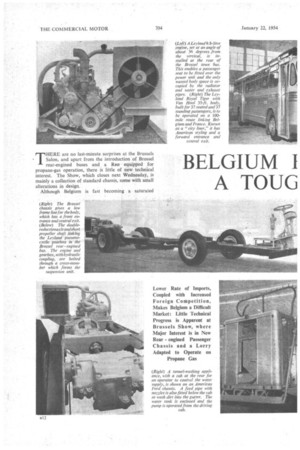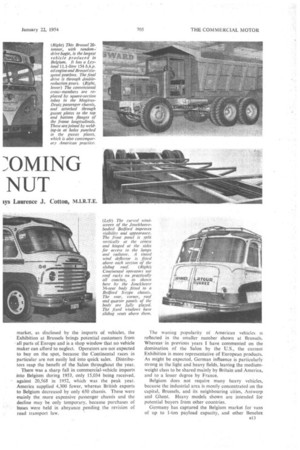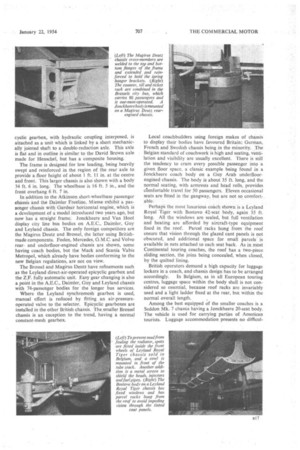BELGIUM I A TOUG :OMING NUT
Page 46

Page 47

Page 48

Page 51

Page 52

If you've noticed an error in this article please click here to report it so we can fix it.
tys Laurence J. Cotton, M.I.R.T.E. THERE are no last-minute surprises at the Brussels Salon, and apart from the introduction of Brossel rear-engined buses and a Reo equipped for propane-gas operation, there is little of new technical interest. The Show, which closes next Wednesday, is mainly a collection of standard chassis, some with small alterations in design.
Although Belgium is fast becoming a saturated market, as disclosed by the imports of vehicles, the Exhibition at Brussels brings potential customers from all parts of Europe and is a shop window that no vehicle maker can afford to neglect. Operators are not expected to buy on the spot, because the Continental races in particular are not easily led into quick sales. Distributors reap the benefit of the Salon throughout the year.
There was a sharp fall in commercial-vehicle imports into Belgium during 1953, only 15,034 being received, against 20,568 in 1952, which • was the peak year. America supplied 4,300 fewer, whereas British exports to Belgium decreased by only 650 chassis. These were mainly the more expensive passenger chassis and the decline may be only temporary, because purchases of buses were held in abeyance pending the revision of road transport law. The waning popularity of American vehicles is reflected in the smaller number shown at Brussels. Whereas in previous years I have commented on the domination of the Salon by the U.S., the current Exhibition is more representative of European products. As might be expected, German influence is particularly strong in the light and heavy fields, leaving the mediumweight class to be shared mainly by Britain and America, and to a lesser degree by France.
Belgium does not require many heavy vehicles, because the industrial area is mostly concentrated on the capital, Brussels, and its neighbouring cities, Antwerp and Ghent. Heavy models shown are intended for potential buyers frOm other countries.
Germany has captured the Belgium market for vans of up to 1-ton payload capacity, and other Benelux B13 countries and Switzerland are similarly biased. Britain has a good hold on supplies of 2-5-ton petrol-engined chassis, and the light oil-engined models of up to 8-ton payload capacity. Where choice of engines is available in a chassis, preference is now being given to petrol, because with 40 per cent. additional tax imposed annually on oil-engined vehicles, coupled with fuel at competitive prices, costs of operation are becoming more nearly equal, and there is always the risk that the tax on oil fuel may be increased.
This decline in the popularity of the oil-engined vehicle is sooner noticed in Belgium than elsewhere, because most transport is local, and a large proportion of commercial vehicles is owner-driven. There is alleged to be little profit in goods transport unless several members of a family concern work.
Alternative Fuel America has a large surplus of propane gas, which is sold in the United States for use in road vehicles at about one-seventh the price of petrol. An enterprising Danish ship owner has introduced a fled of tankers to bring some of this surplus to Europe, and K.L.M., the Dutch airline company, is at present running commercial vehicles and cars on this fuel. At the moment, there is no tax on propane, which is available in the Low Countries at about one-third the price.of petrol. This will probably increase the sales of propane-gas equipment for road vehicles, and there is the possibility of conversion sets being marketed, in addition to new vehicles being supplied with the mixer valve and heavy tanks as initial equipment.
Ets. Hocke can claim to be the first to exhibit a propane-gas vehicle in Europe, the equipment at the Brussels Salon being fitted to a Reo 10-ton chassis. In addition to altering the compression ratio to between 7.6 and 8.5 to 1, one or two containers, depending on the range required, are fitted in place of the normal petrol tank, and a mixer valve replaces the carburetter.
A gallon of propane will give approximately the same mileage as an equal volume of petrol, but the container for the alternative fuel has to be much heavier, because it is required to withstand a working pressure of about 200 p.s.i. The propane equipment adds about 21 cwt. to the unladen weight and is expected initially to cost about £800-£1,000 in Belgium. If the fuel is taxed, the price of the equipment will probably be towered.
It is understood that Opel is also developing similar equipment in Germany, and an announcement is expected early in 1955. In addition to the low cost of propane, there are the inherent advantages of lack of
/ 4
oil dilution and practically no carbon formation, thus reducing maintenance costs.
All new buses in Belgium are now required to have the entrance ahead of the front axle. This has been introduced, as a safety measure, so that the driver can observe passengers boarding. Although this new regulation has not prohibited the forward-engined chassis, it has given an advantage to those with the power units amidships or at the rear. This is indicated in the range of exhibits, including a Magirus Deutz one-man-operated bus, 35 ft. long, which is planned to carry 80 passengers. The Jonckheere body fitted is austere. This type of bus is to be used in Brussels and is equipped with a Z.F. six-speed automatic-control gearbox.
An addition to the rear-engined school is the Brossel, which, as forecast in The Commercial Motor last week, introduced two new models having Leyland components.The smaller, built for operation in Antwerp and by the Belgian State Railways, has a Comet 90 engine and fivespeed gearbox. It is shown with a body about 28 ft. 6 in. long, and the wheelbase is 13 ft. 7 in. The front and rear overhang are 6 ft. 5 in. and 8 ft. 4 in. respectively. The chassis is also to be used for coaches, the wheelbase being increased to 14 ft. 9 in. for a 30-ft. body.
The heavier model has been ordered by the Belgian railways and carries 80 passengers. It has a Leyland 9.8-litre 125 b.h.p. engine installed at about 36° from vertical and in line at the rear, enabling a seat to be provided over the power unit. The Leyland pneumo cyclic gearbox, with hydraulic coupling interposed, is attached as a unit which is linked by a short mechanically jointed shaft to a double-reduction axle. This axle is flat and in outline is similar to the David Brown axle made for Henschel, but has a composite housing..
The frame is designed for low loading, being heavily swept and reinforced in the region of the rear axle to provide a,lloor height of about 1 ft. 11 in. at the centre and front.. This larger chassis is also shown with a body 34 ft. 6 in. long. The wheelbase is 16 ft. 5 in., and the front overhang 6 ft. 7 in.
In addition to the Atkinson short-wheelbase passenger chassis and the Daimler Freeline, Miesse exhibit a passengerchassis with Gardner horizontal engine,, which is a development of a model introduced two years ago, but now has a .straight. frame. Jonckheere and Van Hool display city line bus bodies on A.E.C., Daimler, Guy and Leyland chassis. The only foreign competitors are the Magirus Deutz and Brossel, the latter using Britishmade components. Foden, Mercedes, G.M.C. and Volvo rearand underfloor-engined chassis are shown, some having coach bodies, but the Mack and Scania Vabis Metropol, which already have bodies conforming to the new Belgian regulations, are not on view.
The Brossel and Magirus Deutz have refinements such as the Leyland direct-air-operated epicyclic gearbox and the Z.F. fully automatic unit. Easy gear changing is also a point in the A.E.C., Daimler, Guy and Leyland chassis with 74-passenger bodies for the longer bus services.
Where the Leyland synchromesh gearbox is used, manual effort is reduced by fitting, an air-pressureoperated valve to the selector. Epicyclic gearboxes are installed in the other British chassis, The. smaller Brossel chassis is an exception to the trend, having a normal constant-mesh gearbox. Local coachbuilders using foreign makes of chassis to display their bodies have favoured Britain; German, French and Swedish chassis being in the minority. The Belgian standard of coachwork is high and seating, ventilation and visibility are usually excellent. There is still the tendency to cram every possible passenger into a given floor space, a classic example being found in a Jonckheere coach body on a Guy Arab underfloorengined chassis. The body is about 35 ft. long, and the normal seating, with armrests and head rolls, provides amfortable travel for 50 passengers. Eleven occasional seats are fitted in the gangway, but are not so comfortable.
Perhaps the most luxurious coach shown is a Leyland Royal Tiger with Bostovo 42-seat body, again 35 ft. long. All the windows are sealed, but full ventilation and heating are afforded by aircraft-type equipment fixed in the roof. Parcel racks hung from the roof ensure that vision through the glazed cant panels is not obscured, and additional space for small parcels' is available in nets attached to each seat back. As in most Continental touring coaches, the roof has a two-piece sliding section, the joins being concealed, when closed, by the quilted lining.
British operators demand a high capacity for luggage lockers in a coach, and chassis design has to be arranged accordingly. In Belgium, as in all European touring centres, luggage space within the body shell is not considered so essential, because roof racks are invariably used and a light ladder fixed at the rear, but within the normal overall length.
Among the best equipped of the smaller coaches is a Seddon Mk. 7 chassis having a Jonckheere 20-seat body. The vehicle is used for carrying parties of American tourists. Luggage accommodation presents no difficul :ies because of the roof rack, and the 8-ft.-wide body provides adequate room for seats with armrests. As in most touring coaches, the front is attractively shaped and the windscreen is curved to blend into the side panels, and the wiper motors are secured through the glass.
A Seddon 35-seat coach, with Van Hool body, is shown with the normal brake servo replaced by a Bendix Hydrovac and has a water heater which is supplied from a jacket surrounding the exhaust pipe.
Apart from the Reo propane-gas lorry, few alterations are noticeable in the goods-vehicle exhibits. Volvo display the Titan four-wheeler and the 5-6-tonner with a Perkins P.6 conversion engine is shown by the Belgian distributor. Another new local conversion is the fitting of a Perkins R.6 108 b.h.p. engine to a Reo chassis.
The heaviest vehicle made in Belgium is a new Brossel six-wheeled tipper, which uses a Leyland 11.1litre 154 b.h.p. engine and has a double-reduction drive to the bogie. This model is scheduled for a 20-ton gross load and is fitted with a Dumont 10-cu. yd. dump body extended at the front to protect the cab roof.
It is unfortunate that representative models of the Foden goods and passenger ranges are again sited in an annexe, in company with small caravans. The show finish on the rear-enginal coach chassis sets a standard which is unequalled by any exhibit in the Salon, and the new four-cylinder two-stroke-engined 8-tonner, with left-hand drive, is another attractive model.
Most vehicles are shown by the Belgian distributors as received from the factory and are not specially pre• pared. The standard production finish does not compare with that of the exhibits in British and other Continental shows, and often makers' ranges are poorly represented. It is not unknown for a distributor to sell and deliver to the purchaser a model intended for the Salon.
Exceptions are always found in Austin and Rootes vehicles, which are attractively painted in standard colours and well displayed.




























































































